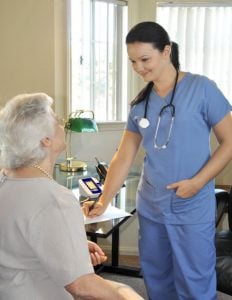Managing Symptoms of Varicose Veins
Regardless of which risk factors you can or can’t control, you can still take action. The following self-care suggestions for Managing Symptoms of Varicose Veins can help you manage your symptoms and improve your quality of life.
Elevating Your Legs
Varicose veins form when the one-way valves inside your veins become stretched out or damaged. This causes a backup of blood in the legs due to gravity. In essence, blood is trickling back down the legs and pooling there. This is known as venous reflux. This is why your legs are more likely to be painful and swollen in the evening, after you’ve been on your feet all day.
What’s a simple solution which counteracts the effects of gravity? Elevating your legs. Performing this one single action can will give immediate, if temporary, relief.
Stretching and Exercising
Don’t worry, a strenuous exercise plan isn’t necessary to manage your symptoms. In fact, it could possibly make things worse.
Instead, focus on gentle aerobic exercises such as walking. Even walking for as little as 30 minutes, on most days of the week, can significantly improve your vein health. The key is engaging the large muscles of the legs, in particular the calves.
Whenever you flex your calves or “toe off,” blood is forced back up your legs, towards the heart. This eliminates blood which has pooled in the lower legs, providing temporary relief from many venous symptoms. Aside from this, regular, gentle exercise has many other health benefits and is a good habit to get into.
If you can’t get up and take an extended walk, be sure to get up and walk briefly every ½ hour. A trip to the bathroom and back is all that’s required. By doing this alone, you’ll receive many of the same benefits as with longer walk. Similarly, simply standing up and pressing down with the calves, as if standing on your tip-toes, also engages calves.
Hydration is Key
What’s one of the best ways to feel foggy-brained and sluggish? It’s simple—don’t drink enough water. Proper hydration is something more of us should pay better attention to. It’s essential for good overall health—every organ system in your body requires plenty of water to function well. This includes your venous system.
How does heat exposure affect spider and varicose veins?
Heat exposure can affect spider and varicose veins in several ways:
1. Dilation of veins: Heat can cause the veins to dilate, which may worsen the appearance of spider and varicose veins, making them more prominent and uncomfortable.
2. Increased blood flow: Heat can increase blood flow to the veins, which can lead to swelling and discomfort, especially in already weakened veins.
3. Discomfort: Exposure to heat can cause discomfort, itching, and a feeling of heaviness in the legs, which are common symptoms of spider and varicose veins.
4. Worsening of symptoms: For some individuals, heat exposure can worsen the symptoms of spider and varicose veins, including pain, swelling, and throbbing sensations.
Can stress contribute to the development or worsening of spider and varicose veins?
Yes, stress can contribute to the development or worsening of spider and varicose veins through several mechanisms:
1. Increased blood pressure: Stress can elevate blood pressure, which can put additional strain on the veins and lead to their weakening or damage.
2. Reduced blood flow: Stress can cause the muscles around the veins to tense up, which can impede blood flow and contribute to the development of spider and varicose veins.
3. Hormonal changes: Stress can lead to the release of stress hormones, such as cortisol, which can affect vein health and contribute to the development of vein issues.
4. Lifestyle factors: During periods of stress, people may be more likely to engage in behaviors that can worsen vein health, such as smoking, poor diet, or lack of exercise.
How do I know if my symptoms require medical attention?
If you experience symptoms such as persistent pain, swelling, warmth, or redness in the affected area, or if you develop ulcers or skin changes around the veins, you should seek medical attention.
When To Look For A Doctor?
Varicose veins are swollen, twisted veins that can appear blue or purple in color, often seen in the legs or feet. They occur when the valves within the veins do not function properly, causing blood to pool and leading to the appearance of bulging veins. While many people may have varicose veins without experiencing any symptoms, in some cases they can cause discomfort, pain, and even complications.
If you are experiencing any of the following symptoms related to varicose veins, it may be time to seek medical attention:
Pain or discomfort: If you are experiencing aching, throbbing, or cramping in your legs or feet, it may be a sign that your varicose veins are causing discomfort.
Swelling: Varicose veins can cause swelling in the legs or feet, which may be accompanied by a feeling of heaviness or fatigue.
Skin changes: Varicose veins can cause changes in the skin around the affected area, such as discoloration or the appearance of spider veins.
Sores or ulcers: In severe cases, varicose veins can lead to the development of sores or ulcers on the skin, which can be painful and require medical attention.
Bleeding: Although rare, varicose veins can rupture and cause bleeding, which should be addressed immediately.
Cosmetic concerns: While varicose veins are not usually a serious medical condition, they can cause cosmetic concerns for some people, and treatment options are available to improve their appearance.
If you are experiencing any of these symptoms, or if your varicose veins are causing you discomfort or affecting your quality of life, it is important to seek medical attention. Your healthcare provider can evaluate your condition and recommend appropriate treatment options, which may include lifestyle changes, compression stockings, or minimally invasive procedures such as sclerotherapy or endovenous laser treatment. In some cases, surgical intervention may be necessary.

